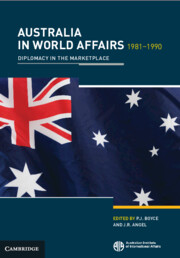Book contents
- Frontmatter
- Contents
- Preface
- Introduction
- Part 1 Australia and the World
- 1 The development of Australian foreign policy
- 2 Australia in the global economy in the 1980s
- 3 The media and foreign policy
- 4 Defence policy and organisation: the search for self-reliance
- 5 The growth of the Australian intelligence community and the Anglo-American connection
- 6 Reflections on Australian foreign policy
- Part 2 Australia and the Regions
- Index
3 - The media and foreign policy
from Part 1 - Australia and the World
Published online by Cambridge University Press: 29 March 2024
- Frontmatter
- Contents
- Preface
- Introduction
- Part 1 Australia and the World
- 1 The development of Australian foreign policy
- 2 Australia in the global economy in the 1980s
- 3 The media and foreign policy
- 4 Defence policy and organisation: the search for self-reliance
- 5 The growth of the Australian intelligence community and the Anglo-American connection
- 6 Reflections on Australian foreign policy
- Part 2 Australia and the Regions
- Index
Summary
Short of war, public interest in foreign policy would seem negligible. A national poll taken in October 1980 found that only 3 per cent of those surveyed viewed foreign policy as a major issue. Of course, had the term foreign policy been substituted with overseas debt, Japanese investment, Asian immigration, the greenhouse effect or disarmament, the response may well have been different. On the whole the media, too, has adopted an uneven approach to foreign policy. ABC television and radio and most of the so-called quality newspapers have specialist reporters covering the area. However, tabloid papers, commercial television and commercial radio devote little attention to serious foreign policy analysis. Aside from periods of major international crises, such as the war in the Persian Gulf, even a cursory glance at the Australian media’s daily output shows foreign policy coverage very much lagging behind domestic politics, sport and entertainment.
Keywords
- Type
- Chapter
- Information
- Australia in World Affairs 1981–1990Diplomacy in the Marketplace, pp. 51 - 62Publisher: Cambridge University PressFirst published in: 2024



